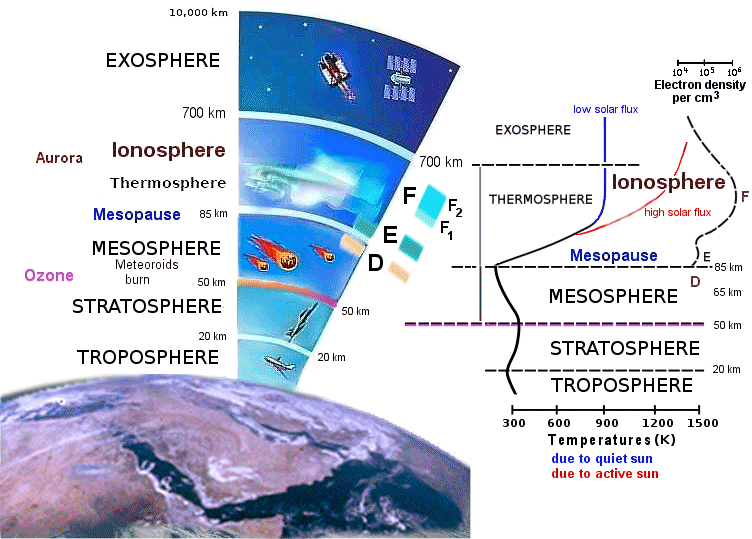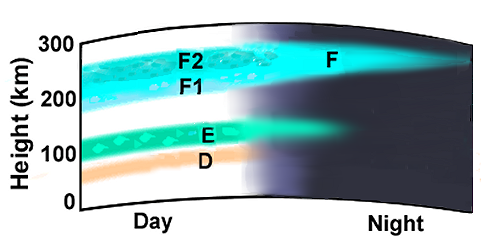
 Radio Communication and the IonosphereThe ionosphere controls HF propagation, based on factors like solar activity, time of day, and frequency.
Radio Communication and the IonosphereThe ionosphere controls HF propagation, based on factors like solar activity, time of day, and frequency.
The ionosphere is a region in the upper-atmosphere that meets space (exosphere).

Figure 1: Ionosphere (Thermosphere) is part Earth's Atmosphere
When solar energy ionizes gases 48 to 800 kilometers above the earth's surface, it produces a mixture of free electrons and ions (known as "plasma").
The high densities of free electrons significantly affect radio communication.
Scientists divide the ionosphere into regions, from top to bottom:
- Skywave communications rely heavily on the uppermost F region of the ionosphere. This region is divided into F1 (lower) and F2 (higher). Solar extreme ultraviolet (EUV) radiation causes the most ionization between 200 and 300 km at noon.
- The E region affects radio waves differently compared to other regions.
- The D region is the lowest. The largest part of the HF absorption takes place in this region, in particular frequencies lower than 10 MHz.
The ionospheric regions do not have sharp boundaries, and the altitudes at which they occur vary during the course of a day and from season to season.
What makes the ionospheric regions distinct?
.png)
Figure 3: Typical Ionospheric electron density profiles
The above graph is based on a review from U.C. Berkeley by Bob Brown, Ph.D, NM7M (SK).↗
Read more about the impact of the ionosphere on radio communication.Ionospheric regional conditions
HF propagation prediction tools
Real time radio propagation map
HF propagation seasonal anomaly
Current solar conditions Ham radio
Current Ham Radio HF Propagation
HF propagation status and alerts
HF Radio Propagation Search Terms
HF propagation for hams explained
Radio propagation for hams explained
Radio propagation seasonal anomaly
Skywave propagation seasonal anomaly
Current HF Band Conditions Online Map
Skywave propagation for hams explained
Current Ham Radio Propagation Conditions
Real-time watching of worldwide ham activity
How does the sun affect radio communication?
Real-time watching of worldwide activity of hams
The Fascinating World of HF Skywave Propagation
